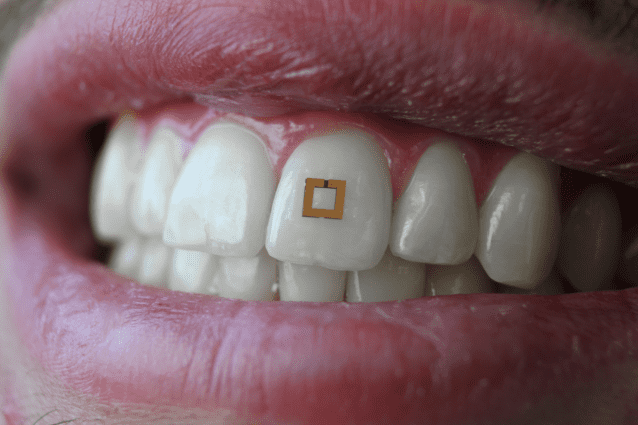Engineers at Tufts University have devised a tiny sensor that is mounted on a user’s tooth to wirelessly relay information on glucose, salt, and alcohol intake. The technology is similar to Radio-Frequency Identification (RFID) that uses radio waves to read and capture information stored on a tag attached to an object.

Monitoring dietary intake is of great importance both in a clinical and research setting. Often, doctors and researchers have to take a patient’s self-reported diet at face value. But having an objective indicator of what kind of food a patient is ingesting would be a lot more desirable.
This is why the Tufts’ dietary sensor is so appealing. Previous such sensors employed extensive wiring, a bulky and uncomfortable mouth guard, and frequent replacement of sensors. In contrast, the new monitoring device measures only 2mm x 2mm, comfortably sitting on the surface of a tooth. Because the data it gathers is transmitted wirelessly, the whole setup is minimally invasive.
The sensor is made of three layers: a central layer that absorbs a chemical, say glucose, sandwiched in between two outer layers consisting of square-shaped gold rings. When an incoming radio wave hits the sensor, it absorbs some of the frequencies and reflects the rest back to the transmitter, just like blue paint absorbs wavelengths in the ‘red’ range and reflects the blue back to our eyes.
If the central layer detects, for instance, salt, the electrical properties of the sensor’s middle layer will change. This causes the sensor to absorb and transmit a different spectrum of radiofrequency waves with a varying intensity. This signature response can tell an app connected to a user’s smartphone what kind of nutrients are being ingested.
“In theory, we can modify the bioresponsive layer in these sensors to target other chemicals – we are really limited only by our creativity,” said Fiorenzo Omenetto, corresponding author and the Frank C. Doble Professor of Engineering at Tufts. “We have extended common RFID [radiofrequency ID] technology to a sensor package that can dynamically read and transmit information on its environment, whether it is affixed to a tooth, to skin, or any other surface.”
The findings are slated to appear in the journal Advanced Materials.






